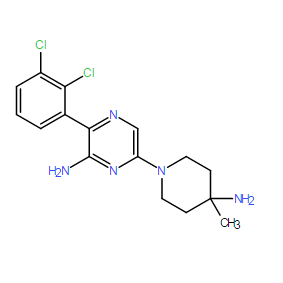| Cas No.: | 1801747-42-1 |
| Chemical Name: | 6-(4-amino-4-methylpiperidin-1-yl)-3-(2,3-dichlorophenyl)pyrazin-2-amine |
| Synonyms: | SHP099; SHP-099; SHP 099. |
| SMILES: | NC1=NC(N2CCC(C)(N)CC2)=CN=C1C3=CC=CC(Cl)=C3Cl |
| Formula: | C16H19Cl2N5 |
| M.Wt: | 352.263 |
| Purity: | >99% |
| Sotrage: | 2 years -20°C Powder, 2 weeks 4°C in DMSO, 6 months -80°C in DMSO |
| Description: | SHP099 is a potent, selective, orally available SHP2 inhibitor with an IC50 of 70 nM. |
| Target: | IC50: 70 nM (SHP2)[1] |
| In Vivo: | After a single doses of 30 and 100 mg/kg (red and blue lines, respectively), dose-dependent exposure and modulation of the pharmacodynamic marker p-ERK is observed in the xenografts. A daily oral dose of 10 or 30 mg/kg yield 19% and 61% tumor growth inhibition, respectively. Tumor stasis is achieved at 100 mg/kg[1]. |
| In Vitro: | The X-ray co-crystal for SHP099 with SHP2 reveals a new interaction with the basic amine and the Phe113 backbone carbonyl. SHP099 shows inhibition of cell proliferation (KYSE-520 model) with an IC50 of 1.4 μM. SHP099 shows high solubility and high permeability with no apparent efflux in Caco-2 cells[1]. SHP099 concurrently binds to the interface of the N-terminal SH2, C-terminal SH2, and protein tyrosine phosphatase domains, thus inhibiting SHP2 activity through an allosteric mechanism. SHP099 suppresses RAS–ERK signalling to inhibit the proliferation of receptor-tyrosine-kinase-driven human cancer cells[2]. |
| Kinase Assay: | The inhibition of SHP2 from the tested compounds (SHP099) concentrations varying from 0.003-100 μM is monitored using an assay in which 0.5 nM of SHP2 is incubated with of 0.5 μM of peptide IRS1_pY1172(dPEG8)pY1222. After 30-60 minutes incubation at the surrogate substrate, DiFMUP is added to the reaction and incubated at 25 °C for 30 minutes. The reaction is then quenched by the addition of 5 μL of a 160 μM solution of bpV(Phen). The fluorescence signal is monitored using a microplate reader using excitation and emission wavelengths of 340 nm and 450 nm, respectively[1]. |
| Cell Assay: | Cells are plated onto 96-well plates in 100 μL medium. SHP099 with various concentrations (1.25, 2.5, 5, 10, 20 μM) are added 24 h after cell plating. At day 5, 50 μL Celltiter-Glo reagent is added, and the luminescent signal is determined[1]. |
| References: | [1]. Garcia Fortanet J, et al. Allosteric Inhibition of SHP2: Identification of a Potent, Selective, and Orally Efficacious Phosphatase Inhibitor. J Med Chem. 2016 Sep 8;59(17):7773-82. [2]. Chen YN, et al. Allosteric inhibition of SHP2 phosphatase inhibits cancers driven by receptor tyrosine kinases. Nature. 2016 Jul 7;535(7610):148-52. [3]. Kostallari E, et al. Hepatic stellate cell-derived PDGFRα-enriched extracellular vesicles promote liver fibrosis in mice through SHP2. Hepatology. 2018 Jan 23. [4]. Eunhee Choi, et al. Mitotic Regulators and the SHP2-MAPK Pathway Promote Insulin Receptor Endocytosis and Feedback Regulation of Insulin Signaling. bioRxiv. September 17, 2018. |

 To enhance service speed and avoid tariff delays, we've opened a US warehouse. All US orders ship directly from our US facility.
To enhance service speed and avoid tariff delays, we've opened a US warehouse. All US orders ship directly from our US facility.




















